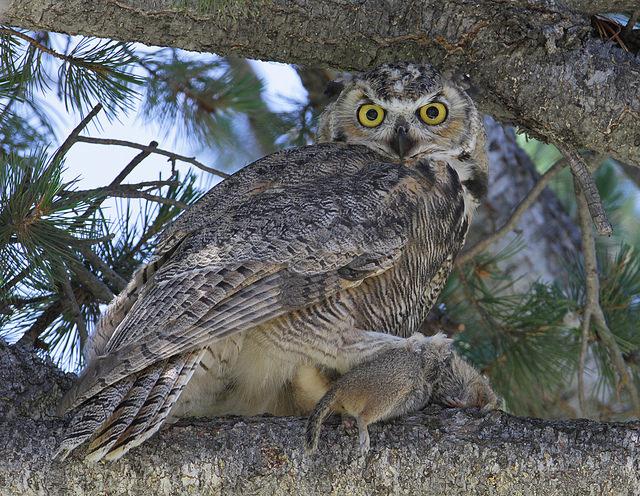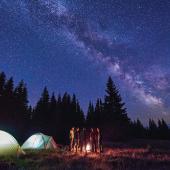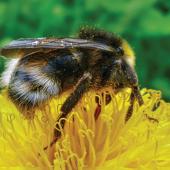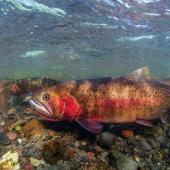Birding for Owls
Having just closed the Jeep door, my eyes haven't yet adjusted to the inky indigo darkness of the March night. There is just enough moon to illuminate the snow with an odd bluish glow. Quickly, the cold weaves its way through my jacket and lies against my skin, sending a shudder from head to toe. I turn on my headlamp and send a tunnel of light through the darkness. Within a couple of minutes, the resonant hoots of a Great Horned Owl glide through the night air. The owl is perched on the limb of a Douglas fir, hunkered down against the trunk.
Owling is an entirely different kind of birding. It is mostly an auditory activity. You will rarely see an owl, but you will hear it. The first step in owling is to become familiar with the owl calls of the region. There are many audio products that feature the calls and songs of the birds of the West and Northern Rockies. Just sit down with the CD or tape, close your eyes, and concentrate on the patternings of the calls. It might also be helpful to write down the calls phonetically as a study aid. Another useful method is to learn how to produce the calls yourself by whistling or hooting, depending on the type of owl call you are learning.
As most owls in the Northern Rockies begin their courtship in late winter or early spring, it is important that you dress appropriately for the cold conditions. When owling, you often stand still for long periods and this results in very cold toes and fingers. Wear boots that are rated for extreme cold and use gloves that have both a liner and shell. Long underwear is a must for owling, and it is very helpful to layer your clothing. Since we lose a good deal of heat through our heads, it is important to wear a hat for insulation. Other equipment needed for owling includes a good headlamp or flashlight. I prefer a headlamp because the beam of light is always where your eyes are focusing. You will use the light source mostly to find your way around and to occasionally catch the eyeshine of an owl. If you are comfortable with the dark and there is some moonlight, it may be better to go without an artificial light source.
When you start out, let your eyes adjust to the night for several minutes or so. Many owlers carry tape players with them, in order to play tapes of owls calling. This will cause the owls to respond in kind. The most important pieces of equipment, however, are your ears. The calls of owls can be rather soft and muted, and they do not carry well over long distances. It is often helpful to cup your hands around your ears like a radar dish. This focuses more of the sound into your ears-low-tech amplifier. It is sometimes difficult to pinpoint the location of the owl from its call. So, you can triangulate the call by listening at one spot and then moving over several yards to listen again. Once you have found the owl, give the appropriate call or mimic a rodent/rabbit distress call. The owl will usually either respond or move closer to investigate.
If you are lucky enough to see the owl, there are several key identification points to note:
- The owl's habitat
- Ear tufts or not
- Eye and bill color
- Plumage and other markings
- The size of the owl
One of the best ways to see a well-camouflaged owl is shine your light toward the owl's general direction. The light will cause an eyeshine if it hits the owl's eyes.
The best time to begin owling is usually just several minutes after sundown. This period of activity lasts for a couple of hours.
 Due to their nocturnal nature and large, wise-looking eyes, owls have always held a special place in the hearts and minds of humankind. Owls have also had a place in the mythology of people throughout the ages. The ancient Greeks believed that the goddess of wisdom, Athene, favored the owl over all other feathered creatures. Many Native American tribes assigned special values of wisdom and prophecy to the owl. The Apache believed that the owl was an indication of an impending death. The Hidatsa thought that the Burrowing Owl was a protective spirit for the warriors of the tribe. The owls of many nursery rhymes and fables are embodiments of wisdom—the owl instructs the main characters on the proper path to take.
Due to their nocturnal nature and large, wise-looking eyes, owls have always held a special place in the hearts and minds of humankind. Owls have also had a place in the mythology of people throughout the ages. The ancient Greeks believed that the goddess of wisdom, Athene, favored the owl over all other feathered creatures. Many Native American tribes assigned special values of wisdom and prophecy to the owl. The Apache believed that the owl was an indication of an impending death. The Hidatsa thought that the Burrowing Owl was a protective spirit for the warriors of the tribe. The owls of many nursery rhymes and fables are embodiments of wisdom—the owl instructs the main characters on the proper path to take.
Another group of nocturnal birds is the nightjars, and, notably in the Northern Rockies, the Common Nighthawk and Common Poorwill. Both of these flying predators are voracious consumers of insects. They have wide, gaping mouths surrounded by bristles, which may help funnel insects into the open mouth. They come out with the setting sun, and they can be seen and heard high above. The Common Nighthawk gives an incredibly booming sound when courting. It is often seen during the daylight hours, especially when the weather is heavily overcast. The Common Poorwill is very elusive; very few people ever see them. The usual way to see this nightjar is to see the red eyeshine of the flying Common Poorwill in front of your headlights.
Out in the inky night, owls and nightjars rule the skies, along with bats. They are objects of fascination as they thrive at a time of day that often terrifies human beings. If we overcome our fears and venture out into the darkness, we can be rewarded with seeing the most elusive of birds in the Northern Rockies.
The Calls of the Owls of the Northern Rockies
Barn Owl: Drawn-out raspy screech
Flammulated Owl: Soft single or double "boot"
Western Screech-owl: Muted trill "hoo-hoo-hoo"
Eastern Screech-owl: Eerie, mellow trill
Great Horned Owl: Resonant "hoo-hoo hoooooo hoo"
Barred Owl: "Who, cooks, for-you? Who, cooks, for-you, all?"
Great Gray Owl: Low "whooo-ooo-ooo"
Northern Pygmy Owl: Whistled "too-too-too-too"
Boreal Owl: Snipe-like winnow
Northern Saw-whet Owl: Monotonous, whistled "hoop"
Long-eared Owl: Low "hoo, hoo, hoo, hoo"
Short-eared Owl: Pulsing "voo-hoo-hoo"
Northern Hawk-owl: Whistlelike "ululululululu"
Owl ID
For specific identification information about Montana's owl species, Montana Fish, Wildlife & Parks has a wonderful resource for both beginning and experienced "owlers." Identification of Montana's Owls is a full-color pamphlet describing each of the 15 owl species known to occur within the Treasure State. Accompanying the textual account for each species is an art plate of that particular owl. Artist Joe Thornbrugh has beautifully rendered these plates with exacting detail. The poses in the renderings are rather realistic, which aids in positive identification. Each account has information that pertains to conspicuous field marks, physical characteristics, habitat, voice, and natural history. The species accounts also house great tidbits of owl knowledge, such as this one about the Short-Eared Owl: "The courtship song is also accompanied by an audible wing-clap and a dive between calls." Of particular interest is the coverage of the lesser-known owls in the state such as the diminutive Flammulated Owl of the ponderosa pine forests, and a boreal species called the Northern Hawk-Owl, which has fewer than 20 sightings in Montana. Identification of Montana's Owls costs 50 cents and can be purchased at Montana Fish, Wildlife & Parks Region 3 Headquarters, 1400 South 19th, Bozeman, MT 59718. Call (406) 994-4042 for more information.










